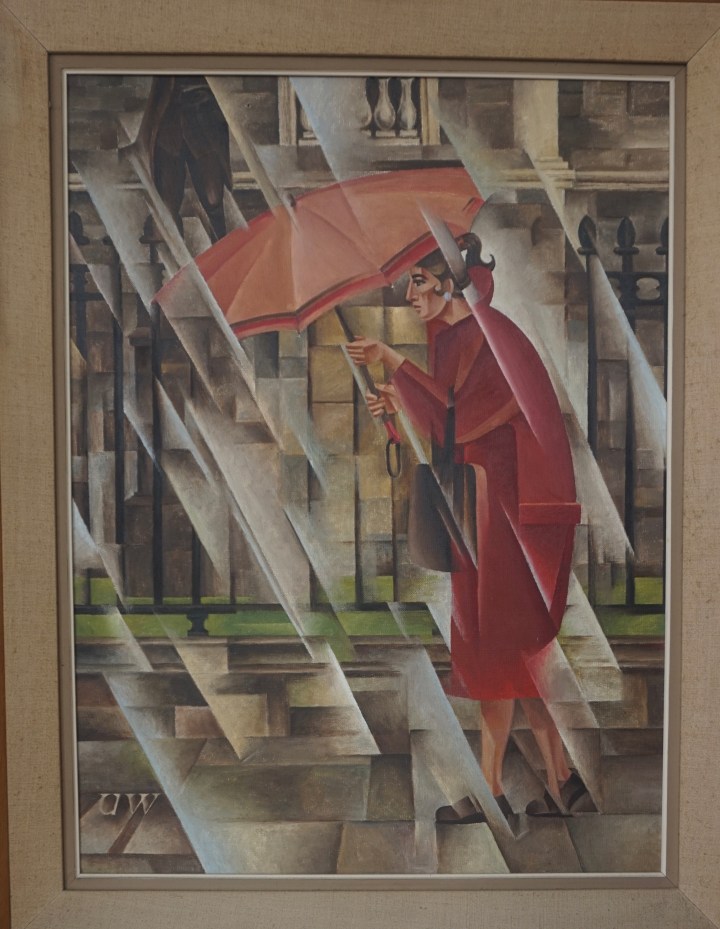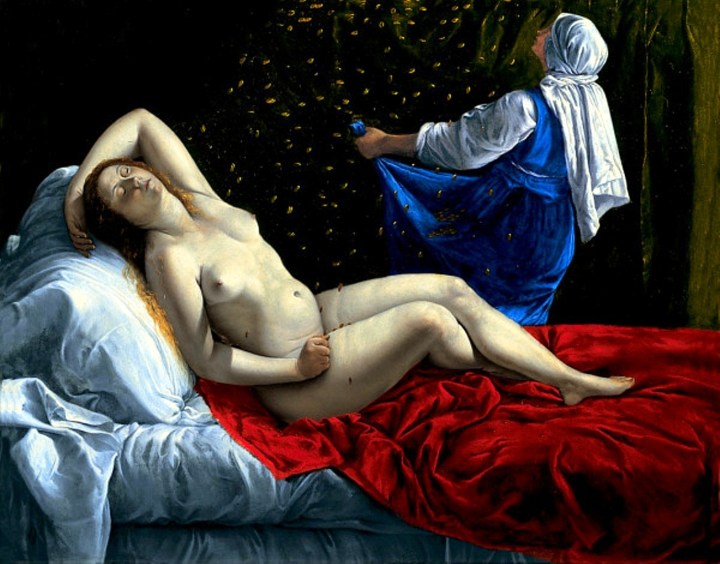
It’s an oil on canvas (31” x 23”), and for many years it hung in the dark dining room of a Victorian-era house you called home. It was a formal room not used much and with a cold northern light. Even in summer you would have to turn the light on to find something in there. The painting was on the chimney breast.
You always liked it; liked but not loved.
Two things changed your mind about the painting. One, you move house. Now “Girl Going by Trinity in the Rain” is in a bright modern living room flooded with light from one wall to floor window (no more property porn descriptions, I promise) and hung on a wide expanse of uncluttered wall and, suddenly, it shines.
A friend of yours, with an artist’s eye, enthuses about it in its new setting and these two factors – a good hanging place and the frank admiration of someone whose taste you trust – makes you re-evaluate it. Suddenly it’s not just love – it’s deep curiosity and fascination. Or are they the same thing?
The first question to ask is where did this painting come from? You know its provenance because the painting was a gift from the artist’s husband to your partner. It was painted in 1959 by a Dublin-born artist, Una Watters (1918–1965), who would be dead six years after it was painted at the untimely age of 47. Its subject matter is modest. It shows a woman in left profile dressed in a red coat gripping an umbrella. Behind her is the stone façade of Trinity College Dublin. (One of the endearing features of the work for you is its depiction of your native city, and of a place you passed daily for more than 20 years, often in the same climactic conditions!)
In the top left-hand of the painting the legs and plinth of the statue of Oliver Goldsmith are just visible. (The 18th century poet, novelist and dramatist – a deeply unhappy student during his stint at Trinity by all accounts – was the author of The Deserted Village, The Vicar of Wakefield and She Stoops to Conquer, among others.)
But, title apart, how do we know it’s raining in Una Watters’ painting? Well, there’s the umbrella, for starters. But there’s also the rain made so solid by the artist’s brush-work that it becomes the central element in the work. Moving in sheets from top left to bottom right of the painting’s surface, the artist has depicted the rain in jagged, almost two-dimensional slashes with geometrical shadows that mimic the stonework on the college façade and create the impression of a torrential downpour that the girl of the title has to battle against.
It’s this rain that gives the work its bold modernist appeal. You can sense the physicality of the driving rain, as flinty and unforgiving as the austere frontage of Trinity. Apart from the girl’s bright red coat and umbrella, the only other departure from the sombre palette is a band of luscious Kelly green that bisects the canvas two-thirds of the way down. This gives the work a very low horizon, thus emphasizing the driving diagonals of the rain that already force the eye downward. The effect is downbeat, as if the elements are literally bearing down and oppressing the figure of the woman. And yet, she’s pressing on, a stoic expression on her stylized face.
The painting has other resonances that are more hidden. It contains what might be classed as a feminist sub-text in the form of word-play. The placement of “Goldsmith”, coupled with the rainy theme, has overtones of the mythical shower of Danaë.
In the Greek myth, Danaë was locked away by her father, King Acrisius of Argos, after an oracle informed him that his daughter’s son would kill him. In order to keep her childless, the king banished Danaë to a tower, away from the reach of men. While no mortal could gain access to Danaë, the god Jupiter was able to gain entry to the tower by transforming himself into a shower of golden rain. Jupiter impregnated Danaë conceiving the boy who would become the hero Perseus. Eventually, he would kill Acrisius accidentally, showing the inescapable reach of Fate.
The impregnation of Danaë via Jupiter’s shower of gold was chosen as a subject by many of the great Renaissance artists including Correggio, Titian, Tintoretto, Orazio Gentileschi, and most interestingly by Gentileschi’s daughter, Artemisia (1593 – c1656) who provided what is regarded by some art historians as a feminist interpretation of the myth. Instead of showing Danaë embracing or being ravished by the raining shower of gold, Artemisia paints her subject’s body language as negative. “Her tightly crossed legs, closed eyes and clenched fist evidence detachment, if not resistance, to the event taking place,” writes Jeanne Morgan Zarucchi. The gold shower is depicted as a bonanza of coins and it is the maidservant in the painting who welcomes the shower with open arms.
Zarucchi sees Artemisia’s rendition of the myth as a comment on the enslaving nature of transactional sex and the lack of choice the woman prostitute had in such encounters. (Gentileschi was herself the centre of a notoriously bitter rape case taken by her father against the painter Agostini Tassi in the early 1600s.)
If the “girl” in Watters’ painting references the Danaë myth, then this Danaë is suited and booted and shielding herself very firmly with her trusty umbrella against the Irish-style shower – read steely, icy grey, rather than golden – that seems to emanate from Goldsmith!
Watters was what we might call these days a part-time artist though this says nothing about her dedication as an artist. She juggled attending the National College of Art – under the mentorship of Maurice MacGonigal – with her day job as a librarian in Dublin’s municipal library system. (One of her paintings, “Four Masters”, is still hanging in Phibsborough branch library where she worked; another “The People’s Gardens” is in the Hugh Lane collection.) She exhibited widely in Dublin in the 50s and 60s. Friends recall her working at her easel set up in the kitchen of the small cottage in Cappagh Cross, Finglas, which she shared with her husband, the Irish language novelist and poet, Eoghan O’Tuarisc. She was also an accomplished designer, illustrator and calligrapher.
There are up to 40 other paintings of Watters extant, mostly in private hands. If anyone knows of, or owns an Una Watters, I’d love to hear about it.

Hi Mary,
Una was my aunt & Godmother. Her husband Eugene was my Godfather & I have very fond memories of them. My mother Sheila Byrne is Una’s sister. My family have works by Una. I have ‘Red Bridge Ballinasloe’ & a self-portrait. My mother also has a self-portrait. My sister has a picture of an old lady by a fire & another of the GPO. There is a portrait of Brian O Higgins hanging in the Local Studies Room in Navan Library. My brothers may have some – I can check. I saw your piece in the Times yesterday – it would be lovely to have a retospective. Coincidentally I attend Art Appreciation classes in the Hugh Lane & I will try & talk to Logan tomorrow. (Phibsboro Library is closed now – not sure where that one got to)
LikeLike
Hi Sheila,
So good to hear from you. In fact, I remembering see a letter from your mother in the Irish Times re the 1966 Rising Sword of Light, when I started looking Una up. I would really like to see your Una’s painitngs at some stage, if that could be arranged. I’ve already spoken to Maire Joyce whom I sure you must know, who responded to the Times piece. My partner is Colbert Kearney who knew Eoghan (he taught him in Finglas) and Una very well and that’s how we came by Girl Going by Trinity – Eoghan gave it to Colbert after Una’s death. It would be really nice to stay in contact – my email is mary.morrissy@gmail.com.
Regards, Mary
LikeLike